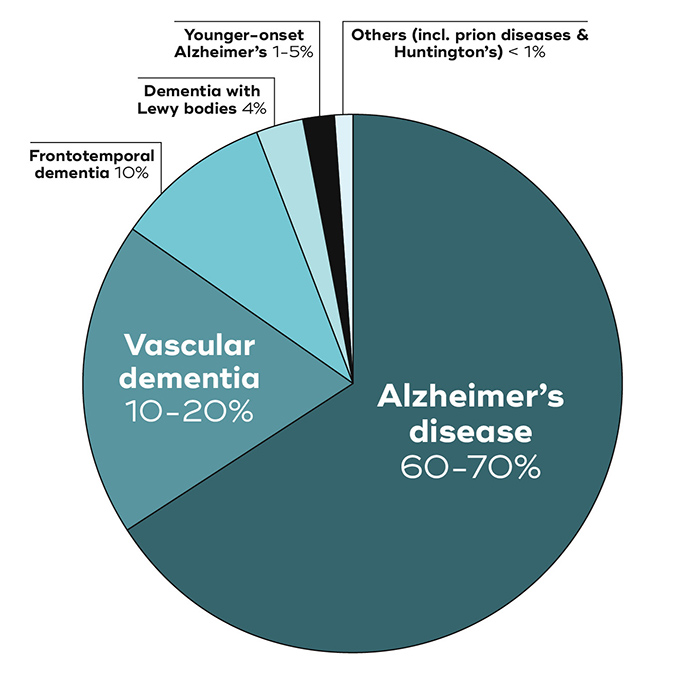Types of dementia

These are the most common forms of dementia.
Alzheimer’s disease
Alzheimer’s disease is the most common form of dementia. Named after the German psychiatrist Alois Alzheimer, the disease is characterised by cognitive decline and memory loss. Two hallmarks of Alzheimer’s are seen in the brain: amyloid-ß plaques and tau tangles, which are caused by the build-up of toxic deposits.
Alzheimer’s is divided into late-onset (age 65+) and younger-onset (under 65). Most cases of late-onset Alzheimer’s have no known cause, and are referred to as sporadic.
Apolipoprotein E (ApoE) is a key gene associated with Alzheimer’s. One of its three common forms,
ApoE 4, increases the risk of developing Alzheimer’s. Studies have identified about a dozen other genes that may also increase the risk.
Alzheimer’s affects women slightly more than men, but the reasons are unknown.
Younger-onset Alzheimer’s
Up to 5% of Alzheimer’s cases are classified as younger-onset, which typically affects people in their 40s and 50s, and even as young as 30. This form has a strong genetic basis, with most cases known to be inherited, and caused by single mutations in three genes: APP, PSEN1 or PSEN2. Each of these mutations cause excessive accumulation of toxic deposits in the brain. This leads to the death of brain cells (neurons) and causes brain tissue to deteriorate. People with these mutated genes are said to have ‘familial Alzheimer’s disease’ (FAD), and multiple family members are usually affected.
Vascular dementia
Vascular dementia is thought to cause about 10-20% of all dementia cases, making it the second most common type. In this condition, changes in the brain’s blood vessels restrict the amount of blood and oxygen reaching particular areas of the brain – resulting in the death of brain cells. A major cause of vascular dementia is stroke, when blockages or haemorrhages cut off blood flow to parts of the brain. The underlying causes are atherosclerosis – the build-up of cholesterol and fat deposits in blood vessels – and arteriosclerosis, the hardening and loss of elasticity in artery walls. Unlike other forms of dementia, vascular dementia is not characterised by aggregations of abnormal proteins.
Frontotemporal dementia
Frontotemporal dementia accounts for about 10% of dementia cases. It is a collection of rare and diverse dementias that mainly affect the frontal and temporal lobes of the brain. These areas are associated with high-order functions such as problem-solving, emotion, motivation, attention and language. The first signs, therefore, are often changes in personality and social behaviour, rather than the memory impairment seen in Alzheimer’s. Frontotemporal dementia often emerges in the earlier stages of life, affecting people aged in their 40s and 50s.
As with Alzheimer’s and many other dementias, the brains of people with this form have unusual deposits of proteins. About one-third of people with frontotemporal dementia have a family history of dementia and half of those seem to have an identifiable genetic basis.
Dementia with Lewy bodies
Cases of dementia with Lewy bodies make up around 4% of dementias. This form gained notoriety in 2014 following the death of comedian and actor Robin Williams, when a post-mortem examination of his brain revealed signs of the disease. Lewy bodies are abnormal deposits within neurons, made up of a protein known as α-synuclein. When these deposits occur in the brain they cause the cognitive loss typical of dementia. But they can also impair neurons that produce dopamine, a chemical that affects your emotions, response to pleasure and pain, and muscle control. The symptoms can therefore be similar to those of Parkinson’s disease. In addition to having trouble with muscle control, people who have dementia with Lewy bodies can have problems with attention and executive function (e.g. memory, planning, decision-making). These symptoms can also be seen in some people with frontotemporal dementia.

